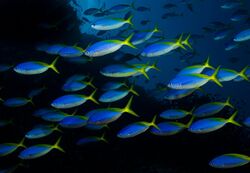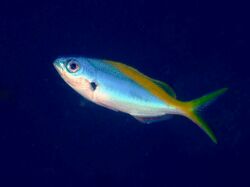Biology:Caesio teres
| Caesio teres | |
|---|---|

| |
| A school of Caesio teres in Fiji | |
| Scientific classification | |
| Kingdom: | |
| Phylum: | |
| Class: | |
| Order: | |
| Family: | |
| Subfamily: | Caesioninae
|
| Genus: | |
| Species: | C. teres
|
| Binomial name | |
| Caesio teres (Seale, 1906)[1]
| |
Caesio teres, the yellow and blueback fusilier, beautiful fusilier, blue and gold fusilier or yellow-tail fusilier, is a pelagic marine fish belonging to the family Caesionidae.
Description
This fusilier grows up to 40 cm (16 in).[2] Its body is fusiform or spindle-shaped and its caudal fin is forked. The mouth is small and terminal. The protusible mouth can be extended forward to swallow food.
The body coloration is blue and yellow on the back. When this fusilier is young, the yellow area starts from the neck, or anterior part of the dorsal fin, to the low part of the caudal peduncle, drawing a diagonal. For older fish, the yellow area is reduced to the caudal fin and the caudal peduncle.[3]
Distribution and habitat
It is widely distributed throughout the tropical waters of the Indian Ocean, Red Sea and Persian Gulf excluded, to the western Pacific Ocean.[2] It lives in mid-water in deep lagoons and close to external reefs in depths from the surface to 50 m (160 ft).[2]
Feeding
Caesio teres feeds on zooplankton, so it is a planktivore.[4]
Behaviour
The yellow and blueback fusilier is diurnal, and lives in groups and forms schools with other caesionids such as Caesio xanthonota. Often, confusion between these two species occurs; Caesio xanthonota has a constant yellow zone which does not change with age as the yellow and blueback fusilier does. This yellow zone starts from the "forehead" between the eyes and finishes to the caudal fin, dorsal fin included.
References
- ↑ Seale, 1906 : Fishes of the South Pacific. Occasional Papers of the Bernice Pauahi Bishop Museum of Polynesian Ethnology and Natural History, vol. 4 n. 1, p. 1-89.
- ↑ 2.0 2.1 2.2 "Caesio teres Yellow and Blueback Fusilier". http://eol.org/pages/1012924/details#habitat.
- ↑ Lieske & Myers, Coral reef fishes, Princeton University Press, 2009, ISBN:9780691089959
- ↑ "Caesio teres Seale, 1906 Yellow and blueback fusilier". http://www.fishbase.org/summary/Caesio-teres.html.
External links
- World Register of Marine Species
- Integrated Taxonomic Information System
- Photos of Caesio teres on Sealife Collection
Wikidata ☰ Q2192025 entry


